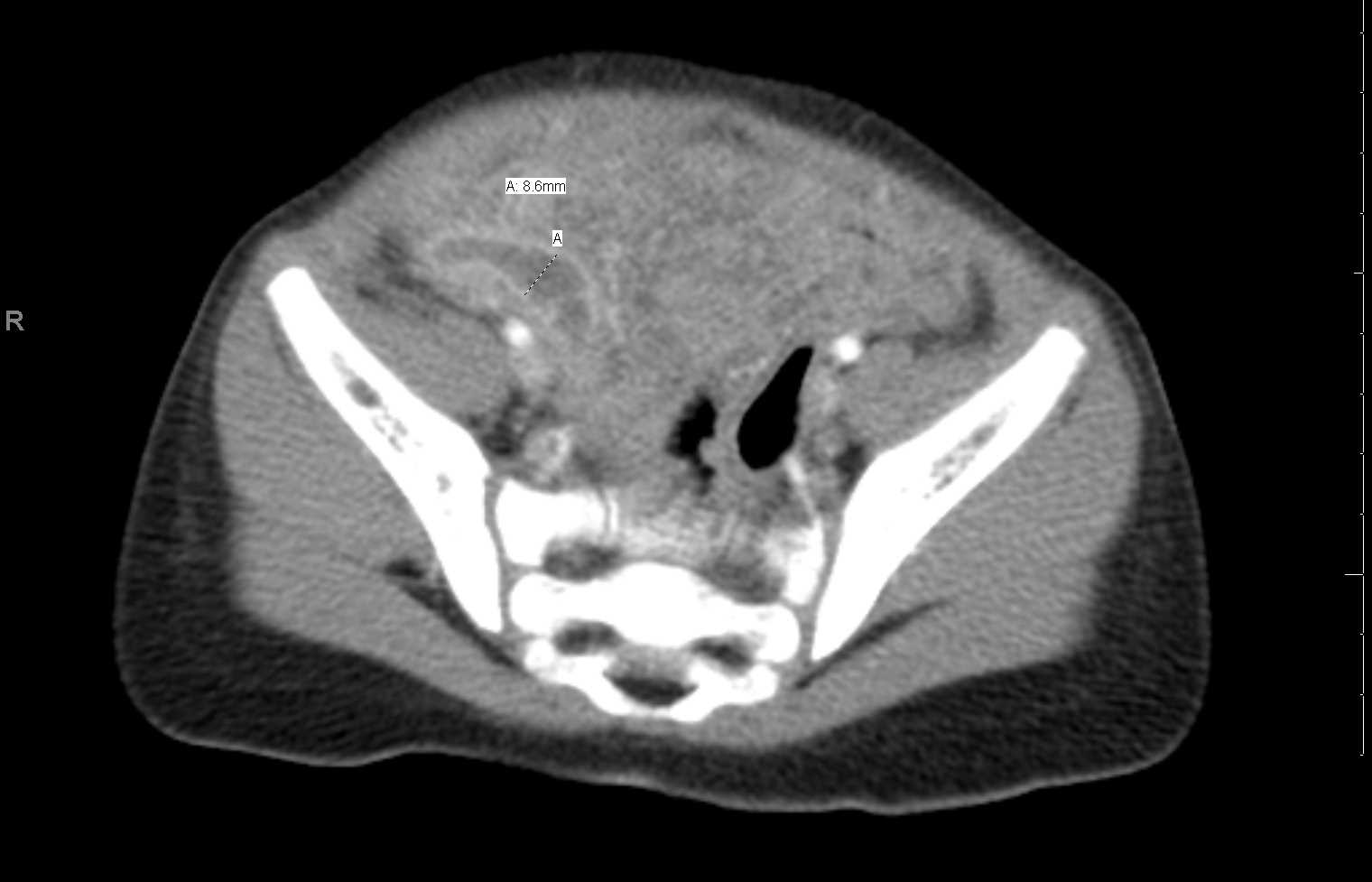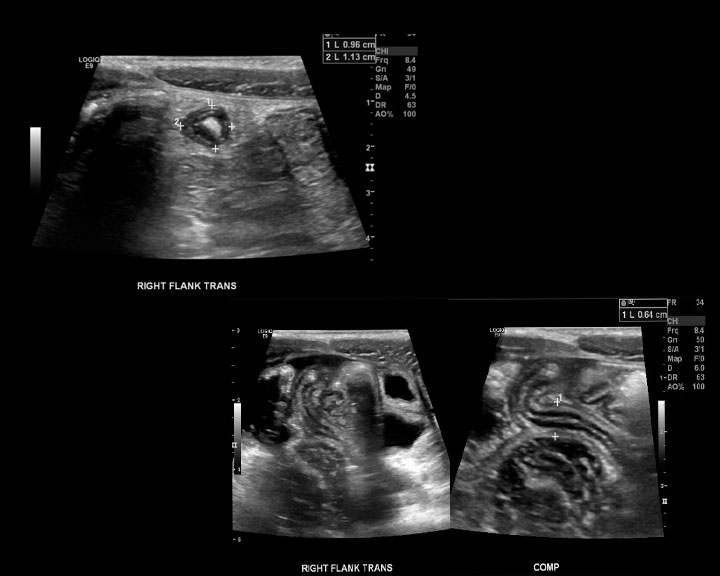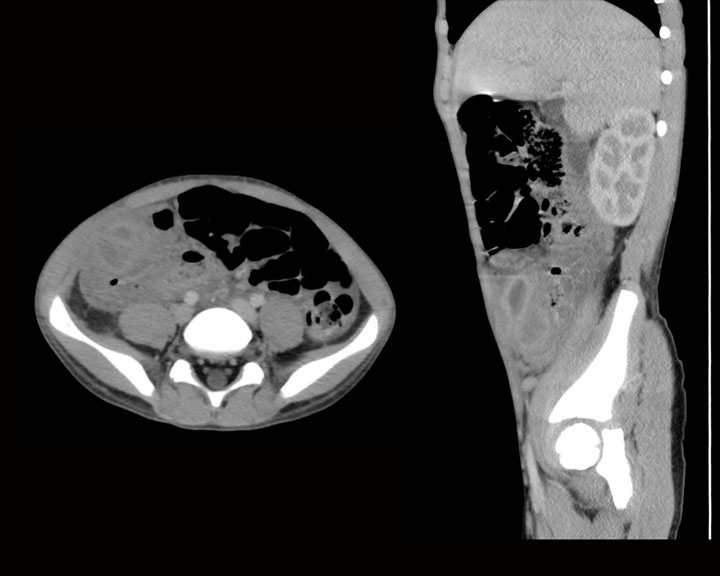[1]
Vaos G, Dimopoulou A, Gkioka E, Zavras N. Immediate surgery or conservative treatment for complicated acute appendicitis in children? A meta-analysis. Journal of pediatric surgery. 2019 Jul:54(7):1365-1371. doi: 10.1016/j.jpedsurg.2018.07.017. Epub 2018 Jul 27
[PubMed PMID: 30115448]
Level 1 (high-level) evidence
[2]
Gignoux B, Blanchet MC, Lanz T, Vulliez A, Saffarini M, Bothorel H, Robert M, Frering V. Should ambulatory appendectomy become the standard treatment for acute appendicitis? World journal of emergency surgery : WJES. 2018:13():28. doi: 10.1186/s13017-018-0191-4. Epub 2018 Jun 28
[PubMed PMID: 29988464]
[3]
Eng KA, Abadeh A, Ligocki C, Lee YK, Moineddin R, Adams-Webber T, Schuh S, Doria AS. Acute Appendicitis: A Meta-Analysis of the Diagnostic Accuracy of US, CT, and MRI as Second-Line Imaging Tests after an Initial US. Radiology. 2018 Sep:288(3):717-727. doi: 10.1148/radiol.2018180318. Epub 2018 Jun 19
[PubMed PMID: 29916776]
Level 1 (high-level) evidence
[4]
Kartal İ. Childhood neuroendocrine tumors of the digestive system: A single center experience. Medicine. 2022 Feb 11:101(6):e28795. doi: 10.1097/MD.0000000000028795. Epub
[PubMed PMID: 35147110]
[5]
Khan MS, Chaudhry MBH, Shahzad N, Tariq M, Memon WA, Alvi AR. Risk of appendicitis in patients with incidentally discovered appendicoliths. The Journal of surgical research. 2018 Jan:221():84-87. doi: 10.1016/j.jss.2017.08.021. Epub 2017 Sep 18
[PubMed PMID: 29229158]
[6]
Stringer MD. Acute appendicitis. Journal of paediatrics and child health. 2017 Nov:53(11):1071-1076. doi: 10.1111/jpc.13737. Epub 2017 Oct 17
[PubMed PMID: 29044790]
[7]
Bhangu A, Søreide K, Di Saverio S, Assarsson JH, Drake FT. Acute appendicitis: modern understanding of pathogenesis, diagnosis, and management. Lancet (London, England). 2015 Sep 26:386(10000):1278-1287. doi: 10.1016/S0140-6736(15)00275-5. Epub
[PubMed PMID: 26460662]
Level 3 (low-level) evidence
[8]
Ucar Karabulut K, Erinanc H, Yonar A, Kisinma A, Ucar Y. Correlation of histological diagnosis and laboratory findings in distinguishing acute appendicitis and lymphoid hyperplasia. Annals of surgical treatment and research. 2022 Nov:103(5):306-311. doi: 10.4174/astr.2022.103.5.306. Epub 2022 Nov 1
[PubMed PMID: 36452309]
[9]
Narula N, Gibbs KE, Kong F, Mukherjee I. Appendiceal Intussusception, Diverticula, and Fecalith Associated With Appendicitis. The American surgeon. 2022 Sep 8:():31348221126954. doi: 10.1177/00031348221126954. Epub 2022 Sep 8
[PubMed PMID: 36074037]
[10]
Buckius MT, McGrath B, Monk J, Grim R, Bell T, Ahuja V. Changing epidemiology of acute appendicitis in the United States: study period 1993-2008. The Journal of surgical research. 2012 Jun 15:175(2):185-90. doi: 10.1016/j.jss.2011.07.017. Epub 2011 Aug 9
[PubMed PMID: 22099604]
[11]
Sahm M, Koch A, Schmidt U, Wolff S, Pross M, Gastinger I, Lippert H. [Acute appendicitis - clinical health-service research on the current surgical therapy]. Zentralblatt fur Chirurgie. 2013 Jun:138(3):270-7. doi: 10.1055/s-0031-1283947. Epub 2012 Mar 16
[PubMed PMID: 22426968]
[12]
Addiss DG, Shaffer N, Fowler BS, Tauxe RV. The epidemiology of appendicitis and appendectomy in the United States. American journal of epidemiology. 1990 Nov:132(5):910-25
[PubMed PMID: 2239906]
[13]
Téoule P, Laffolie J, Rolle U, Reissfelder C. Acute Appendicitis in Childhood and Adulthood. Deutsches Arzteblatt international. 2020 Nov 6:117(45):764-774. doi: 10.3238/arztebl.2020.0764. Epub
[PubMed PMID: 33533331]
[14]
Hamilton AL, Kamm MA, Ng SC, Morrison M. Proteus spp. as Putative Gastrointestinal Pathogens. Clinical microbiology reviews. 2018 Jul:31(3):. doi: 10.1128/CMR.00085-17. Epub 2018 Jun 13
[PubMed PMID: 29899011]
[15]
Redden M, Ghadiri M. Acute appendicitis with associated trichobezoar of feline hair. Journal of surgical case reports. 2022 Mar:2022(3):rjac133. doi: 10.1093/jscr/rjac133. Epub 2022 Mar 29
[PubMed PMID: 35355580]
Level 3 (low-level) evidence
[16]
Correa J, Jimeno J, Vallverdu H, Bizzoca C, Collado-Roura F, Estalella L, Hermoso J, Silva N, Sanchez-Pradell C, Parés D. Correlation between intraoperative surgical diagnosis of complicated acute appendicitis and the pathology report: clinical implications. Surgical infections. 2015 Feb:16(1):41-4. doi: 10.1089/sur.2013.155. Epub
[PubMed PMID: 25761079]
[17]
Hoffmann JC, Trimborn CP, Hoffmann M, Schröder R, Förster S, Dirks K, Tannapfel A, Anthuber M, Hollerweger A. Classification of acute appendicitis (CAA): treatment directed new classification based on imaging (ultrasound, computed tomography) and pathology. International journal of colorectal disease. 2021 Nov:36(11):2347-2360. doi: 10.1007/s00384-021-03940-8. Epub 2021 Jun 18
[PubMed PMID: 34143276]
[18]
Snyder MJ, Guthrie M, Cagle S. Acute Appendicitis: Efficient Diagnosis and Management. American family physician. 2018 Jul 1:98(1):25-33
[PubMed PMID: 30215950]
[19]
van Aerts RMM, van de Laarschot LFM, Banales JM, Drenth JPH. Clinical management of polycystic liver disease. Journal of hepatology. 2018 Apr:68(4):827-837. doi: 10.1016/j.jhep.2017.11.024. Epub 2017 Nov 24
[PubMed PMID: 29175241]
[20]
Iwamoto Y, Onishi T, Suzuki R, Arima K, Sugimura Y. Uretero-appendiceal fistula. International journal of urology : official journal of the Japanese Urological Association. 2008 Feb:15(2):180-1. doi: 10.1111/j.1442-2042.2007.01952.x. Epub
[PubMed PMID: 18269461]
[21]
Yang HR, Wang YC, Chung PK, Chen WK, Jeng LB, Chen RJ. Laboratory tests in patients with acute appendicitis. ANZ journal of surgery. 2006 Jan-Feb:76(1-2):71-4
[PubMed PMID: 16483301]
[22]
Withers AS, Grieve A, Loveland JA. Correlation of white cell count and CRP in acute appendicitis in paediatric patients. South African journal of surgery. Suid-Afrikaanse tydskrif vir chirurgie. 2019 Dec:57(4):40
[PubMed PMID: 31773931]
[23]
Rao PM. Cecal apical changes with appendicitis: diagnosing appendicitis when the appendix is borderline abnormal or not seen. Journal of computer assisted tomography. 1999 Jan-Feb:23(1):55-9
[PubMed PMID: 10050808]
[24]
Pooler BD, Repplinger MD, Reeder SB, Pickhardt PJ. MRI of the Nontraumatic Acute Abdomen: Description of Findings and Multimodality Correlation. Gastroenterology clinics of North America. 2018 Sep:47(3):667-690. doi: 10.1016/j.gtc.2018.04.010. Epub 2018 Jul 7
[PubMed PMID: 30115443]
[25]
Swenson DW, Ayyala RS, Sams C, Lee EY. Practical Imaging Strategies for Acute Appendicitis in Children. AJR. American journal of roentgenology. 2018 Oct:211(4):901-909. doi: 10.2214/AJR.18.19778. Epub 2018 Aug 14
[PubMed PMID: 30106612]
[26]
Kim DW, Suh CH, Yoon HM, Kim JR, Jung AY, Lee JS, Cho YA. Visibility of Normal Appendix on CT, MRI, and Sonography: A Systematic Review and Meta-Analysis. AJR. American journal of roentgenology. 2018 Sep:211(3):W140-W150. doi: 10.2214/AJR.17.19321. Epub 2018 Jul 24
[PubMed PMID: 30040469]
Level 1 (high-level) evidence
[27]
Hwang ME. Sonography and Computed Tomography in Diagnosing Acute Appendicitis. Radiologic technology. 2018 Jan:89(3):224-237
[PubMed PMID: 29298941]
[28]
Kave M, Parooie F, Salarzaei M. Pregnancy and appendicitis: a systematic review and meta-analysis on the clinical use of MRI in diagnosis of appendicitis in pregnant women. World journal of emergency surgery : WJES. 2019:14():37. doi: 10.1186/s13017-019-0254-1. Epub 2019 Jul 22
[PubMed PMID: 31367227]
Level 1 (high-level) evidence
[29]
Awayshih MMA, Nofal MN, Yousef AJ. Evaluation of Alvarado score in diagnosing acute appendicitis. The Pan African medical journal. 2019:34():15. doi: 10.11604/pamj.2019.34.15.17803. Epub 2019 Sep 6
[PubMed PMID: 31762884]
[30]
CODA Collaborative, Flum DR, Davidson GH, Monsell SE, Shapiro NI, Odom SR, Sanchez SE, Drake FT, Fischkoff K, Johnson J, Patton JH, Evans H, Cuschieri J, Sabbatini AK, Faine BA, Skeete DA, Liang MK, Sohn V, McGrane K, Kutcher ME, Chung B, Carter DW, Ayoung-Chee P, Chiang W, Rushing A, Steinberg S, Foster CS, Schaetzel SM, Price TP, Mandell KA, Ferrigno L, Salzberg M, DeUgarte DA, Kaji AH, Moran GJ, Saltzman D, Alam HB, Park PK, Kao LS, Thompson CM, Self WH, Yu JT, Wiebusch A, Winchell RJ, Clark S, Krishnadasan A, Fannon E, Lavallee DC, Comstock BA, Bizzell B, Heagerty PJ, Kessler LG, Talan DA. A Randomized Trial Comparing Antibiotics with Appendectomy for Appendicitis. The New England journal of medicine. 2020 Nov 12:383(20):1907-1919. doi: 10.1056/NEJMoa2014320. Epub 2020 Oct 5
[PubMed PMID: 33017106]
Level 1 (high-level) evidence
[31]
Hansson J, Körner U, Khorram-Manesh A, Solberg A, Lundholm K. Randomized clinical trial of antibiotic therapy versus appendicectomy as primary treatment of acute appendicitis in unselected patients. The British journal of surgery. 2009 May:96(5):473-81. doi: 10.1002/bjs.6482. Epub
[PubMed PMID: 19358184]
Level 1 (high-level) evidence
[32]
Styrud J, Eriksson S, Nilsson I, Ahlberg G, Haapaniemi S, Neovius G, Rex L, Badume I, Granström L. Appendectomy versus antibiotic treatment in acute appendicitis. a prospective multicenter randomized controlled trial. World journal of surgery. 2006 Jun:30(6):1033-7
[PubMed PMID: 16736333]
Level 1 (high-level) evidence
[33]
Salminen P, Tuominen R, Paajanen H, Rautio T, Nordström P, Aarnio M, Rantanen T, Hurme S, Mecklin JP, Sand J, Virtanen J, Jartti A, Grönroos JM. Five-Year Follow-up of Antibiotic Therapy for Uncomplicated Acute Appendicitis in the APPAC Randomized Clinical Trial. JAMA. 2018 Sep 25:320(12):1259-1265. doi: 10.1001/jama.2018.13201. Epub
[PubMed PMID: 30264120]
Level 1 (high-level) evidence
[34]
Vons C, Barry C, Maitre S, Pautrat K, Leconte M, Costaglioli B, Karoui M, Alves A, Dousset B, Valleur P, Falissard B, Franco D. Amoxicillin plus clavulanic acid versus appendicectomy for treatment of acute uncomplicated appendicitis: an open-label, non-inferiority, randomised controlled trial. Lancet (London, England). 2011 May 7:377(9777):1573-9. doi: 10.1016/S0140-6736(11)60410-8. Epub
[PubMed PMID: 21550483]
Level 1 (high-level) evidence
[35]
Writing Group for the CODA Collaborative, Zhang IY, Voldal EC, Davidson GH, Liao JM, Thompson CM, Self WH, Kao LS, Cherry-Bukowiec J, Raghavendran K, Kaji AH, DeUgarte DA, Gonzalez E, Mandell KA, Ohe K, Siparsky N, Price TP, Evans DC, Victory J, Chiang W, Jones A, Kutcher ME, Ciomperlik H, Liang MK, Evans HL, Faine BA, Neufeld M, Sanchez SE, Krishnadasan A, Comstock BA, Heagerty PJ, Lawrence SO, Monsell SE, Fannon EEC, Kessler LG, Talan DA, Flum DR. Association of Patient Belief About Success of Antibiotics for Appendicitis and Outcomes: A Secondary Analysis of the CODA Randomized Clinical Trial. JAMA surgery. 2022 Dec 1:157(12):1080-1087. doi: 10.1001/jamasurg.2022.4765. Epub
[PubMed PMID: 36197656]
Level 1 (high-level) evidence
[36]
Sartelli M, Baiocchi GL, Di Saverio S, Ferrara F, Labricciosa FM, Ansaloni L, Coccolini F, Vijayan D, Abbas A, Abongwa HK, Agboola J, Ahmed A, Akhmeteli L, Akkapulu N, Akkucuk S, Altintoprak F, Andreiev AL, Anyfantakis D, Atanasov B, Bala M, Balalis D, Baraket O, Bellanova G, Beltran M, Melo RB, Bini R, Bouliaris K, Brunelli D, Castillo A, Catani M, Che Jusoh A, Chichom-Mefire A, Cocorullo G, Coimbra R, Colak E, Costa S, Das K, Delibegovic S, Demetrashvili Z, Di Carlo I, Kiseleva N, El Zalabany T, Faro M, Ferreira M, Fraga GP, Gachabayov M, Ghnnam WM, Giménez Maurel T, Gkiokas G, Gomes CA, Griffiths E, Guner A, Gupta S, Hecker A, Hirano ES, Hodonou A, Hutan M, Ioannidis O, Isik A, Ivakhov G, Jain S, Jokubauskas M, Karamarkovic A, Kauhanen S, Kaushik R, Kavalakat A, Kenig J, Khokha V, Khor D, Kim D, Kim JI, Kong V, Lasithiotakis K, Leão P, Leon M, Litvin A, Lohsiriwat V, López-Tomassetti Fernandez E, Lostoridis E, Maciel J, Major P, Dimova A, Manatakis D, Marinis A, Martinez-Perez A, Marwah S, McFarlane M, Mesina C, Pędziwiatr M, Michalopoulos N, Misiakos E, Mohamedahmed A, Moldovanu R, Montori G, Mysore Narayana R, Negoi I, Nikolopoulos I, Novelli G, Novikovs V, Olaoye I, Omari A, Ordoñez CA, Ouadii M, Ozkan Z, Pal A, Palini GM, Partecke LI, Pata F, Pędziwiatr M, Pereira Júnior GA, Pintar T, Pisarska M, Ploneda-Valencia CF, Pouggouras K, Prabhu V, Ramakrishnapillai P, Regimbeau JM, Reitz M, Rios-Cruz D, Saar S, Sakakushev B, Seretis C, Sazhin A, Shelat V, Skrovina M, Smirnov D, Spyropoulos C, Strzałka M, Talving P, Teixeira Gonsaga RA, Theobald G, Tomadze G, Torba M, Tranà C, Ulrych J, Uzunoğlu MY, Vasilescu A, Occhionorelli S, Venara A, Vereczkei A, Vettoretto N, Vlad N, Walędziak M, Yilmaz TU, Yuan KC, Yunfeng C, Zilinskas J, Grelpois G, Catena F. Prospective Observational Study on acute Appendicitis Worldwide (POSAW). World journal of emergency surgery : WJES. 2018:13():19. doi: 10.1186/s13017-018-0179-0. Epub 2018 Apr 16
[PubMed PMID: 29686725]
Level 2 (mid-level) evidence
[37]
Harnoss JC, Zelienka I, Probst P, Grummich K, Müller-Lantzsch C, Harnoss JM, Ulrich A, Büchler MW, Diener MK. Antibiotics Versus Surgical Therapy for Uncomplicated Appendicitis: Systematic Review and Meta-analysis of Controlled Trials (PROSPERO 2015: CRD42015016882). Annals of surgery. 2017 May:265(5):889-900. doi: 10.1097/SLA.0000000000002039. Epub
[PubMed PMID: 27759621]
Level 1 (high-level) evidence
[38]
Kumar S, Jalan A, Patowary BN, Shrestha S. Laparoscopic Appendectomy Versus Open Appendectomy for Acute Appendicitis: A Prospective Comparative Study. Kathmandu University medical journal (KUMJ). 2016 Jul-Sept.:14(55):244-248
[PubMed PMID: 28814687]
Level 2 (mid-level) evidence
[39]
Zani A, Hall NJ, Rahman A, Morini F, Pini Prato A, Friedmacher F, Koivusalo A, van Heurn E, Pierro A. European Paediatric Surgeons' Association Survey on the Management of Pediatric Appendicitis. European journal of pediatric surgery : official journal of Austrian Association of Pediatric Surgery ... [et al] = Zeitschrift fur Kinderchirurgie. 2019 Feb:29(1):53-61. doi: 10.1055/s-0038-1668139. Epub 2018 Aug 15
[PubMed PMID: 30112745]
Level 3 (low-level) evidence
[40]
Antonacci N, Ricci C, Taffurelli G, Monari F, Del Governatore M, Caira A, Leone A, Cervellera M, Minni F, Cola B. Laparoscopic appendectomy: Which factors are predictors of conversion? A high-volume prospective cohort study. International journal of surgery (London, England). 2015 Sep:21():103-7. doi: 10.1016/j.ijsu.2015.06.089. Epub 2015 Jul 29
[PubMed PMID: 26231996]
[41]
Thambidorai CR, Aman Fuad Y. Laparoscopic appendicectomy for complicated appendicitis in children. Singapore medical journal. 2008 Dec:49(12):994-7
[PubMed PMID: 19122949]
[42]
Siribumrungwong B, Chantip A, Noorit P, Wilasrusmee C, Ungpinitpong W, Chotiya P, Leerapan B, Woratanarat P, McEvoy M, Attia J, Thakkinstian A. Comparison of Superficial Surgical Site Infection Between Delayed Primary Versus Primary Wound Closure in Complicated Appendicitis: A Randomized Controlled Trial. Annals of surgery. 2018 Apr:267(4):631-637. doi: 10.1097/SLA.0000000000002464. Epub
[PubMed PMID: 28796014]
Level 1 (high-level) evidence
[43]
Turk E, Acimis NM, Karaca F, Edirne Y, Tan A, Kilic C. The effect on postoperative pain of pulling the rectus muscle medially during open appendectomy surgery. Minerva chirurgica. 2014 Jun:69(3):141-6
[PubMed PMID: 24970302]
[44]
Hucl T, Benes M, Kocik M, Splichalova A, Maluskova J, Krak M, Lanska V, Heczkova M, Kieslichova E, Oliverius M, Spicak J. Comparison of Inflammatory Response to Transgastric and Transcolonic NOTES. Gastroenterology research and practice. 2016:2016():7320275. doi: 10.1155/2016/7320275. Epub 2016 Jun 14
[PubMed PMID: 27403157]
[45]
Khashab MA, Kalloo AN. NOTES: current status and new horizons. Gastroenterology. 2012 Apr:142(4):704-710.e1. doi: 10.1053/j.gastro.2012.02.022. Epub 2012 Feb 17
[PubMed PMID: 22349111]
[46]
Ahmed K, Wang TT, Patel VM, Nagpal K, Clark J, Ali M, Deeba S, Ashrafian H, Darzi A, Athanasiou T, Paraskeva P. The role of single-incision laparoscopic surgery in abdominal and pelvic surgery: a systematic review. Surgical endoscopy. 2011 Feb:25(2):378-96. doi: 10.1007/s00464-010-1208-6. Epub 2010 Jul 10
[PubMed PMID: 20623239]
Level 1 (high-level) evidence
[47]
Jiang J, Wu Y, Tang Y, Shen Z, Chen G, Huang Y, Zheng S, Zheng Y, Dong R. A novel nomogram for the differential diagnosis between advanced and early appendicitis in pediatric patients. Biomarkers in medicine. 2019 Oct:13(14):1157-1173. doi: 10.2217/bmm-2019-0036. Epub 2019 Sep 27
[PubMed PMID: 31559834]
[48]
Van de Moortele M, De Hertogh G, Sagaert X, Van Cutsem E. Appendiceal cancer : a review of the literature. Acta gastro-enterologica Belgica. 2020 Jul-Sep:83(3):441-448
[PubMed PMID: 33094592]
[49]
Zhang K, Meyerson C, Kassardjian A, Westbrook LM, Zheng W, Wang HL. Goblet Cell Carcinoid/Carcinoma: An Update. Advances in anatomic pathology. 2019 Mar:26(2):75-83. doi: 10.1097/PAP.0000000000000222. Epub
[PubMed PMID: 30601149]
Level 3 (low-level) evidence
[50]
Marte A, Sabatino MD, Cautiero P, Accardo M, Romano M, Parmeggiani P. Unexpected finding of laparoscopic appendectomy: appendix MALT lymphoma in children. Pediatric surgery international. 2008 Apr:24(4):471-3
[PubMed PMID: 17628810]
[51]
Xie X, Zhou Z, Song Y, Li W, Diao D, Dang C, Zhang H. The Management and Prognostic Prediction of Adenocarcinoma of Appendix. Scientific reports. 2016 Dec 16:6():39027. doi: 10.1038/srep39027. Epub 2016 Dec 16
[PubMed PMID: 27982068]
[52]
Morano WF, Gleeson EM, Sullivan SH, Padmanaban V, Mapow BL, Shewokis PA, Esquivel J, Bowne WB. Clinicopathological Features and Management of Appendiceal Mucoceles: A Systematic Review. The American surgeon. 2018 Feb 1:84(2):273-281
[PubMed PMID: 29580358]
Level 1 (high-level) evidence
[53]
Calis H. Morbidity and Mortality in Appendicitis in the Elderly. Journal of the College of Physicians and Surgeons--Pakistan : JCPSP. 2018 Nov:28(11):875-878. doi: 10.29271/jcpsp.2018.11.875. Epub
[PubMed PMID: 30369383]
[54]
Keller CA, Dudley RM, Huycke EM, Chow RB, Ali A. Stump appendicitis. Radiology case reports. 2022 Jul:17(7):2534-2536. doi: 10.1016/j.radcr.2022.04.034. Epub 2022 May 13
[PubMed PMID: 35601384]
Level 3 (low-level) evidence
[55]
Gorter RR, Eker HH, Gorter-Stam MA, Abis GS, Acharya A, Ankersmit M, Antoniou SA, Arolfo S, Babic B, Boni L, Bruntink M, van Dam DA, Defoort B, Deijen CL, DeLacy FB, Go PM, Harmsen AM, van den Helder RS, Iordache F, Ket JC, Muysoms FE, Ozmen MM, Papoulas M, Rhodes M, Straatman J, Tenhagen M, Turrado V, Vereczkei A, Vilallonga R, Deelder JD, Bonjer J. Diagnosis and management of acute appendicitis. EAES consensus development conference 2015. Surgical endoscopy. 2016 Nov:30(11):4668-4690
[PubMed PMID: 27660247]
Level 3 (low-level) evidence
[56]
Smith MP, Katz DS, Lalani T, Carucci LR, Cash BD, Kim DH, Piorkowski RJ, Small WC, Spottswood SE, Tulchinsky M, Yaghmai V, Yee J, Rosen MP. ACR Appropriateness Criteria® Right Lower Quadrant Pain--Suspected Appendicitis. Ultrasound quarterly. 2015 Jun:31(2):85-91. doi: 10.1097/RUQ.0000000000000118. Epub
[PubMed PMID: 25364964]
[57]
Schoel L, Maizlin II, Koppelmann T, Onwubiko C, Shroyer M, Douglas A, Russell RT. Improving imaging strategies in pediatric appendicitis: a quality improvement initiative. The Journal of surgical research. 2018 Oct:230():131-136. doi: 10.1016/j.jss.2018.04.043. Epub 2018 May 25
[PubMed PMID: 30100029]
Level 2 (mid-level) evidence
[58]
Zosimas D, Lykoudis PM, Pilavas A, Burke J, Leung P, Strano G, Shatkar V. Open versus laparoscopic appendicectomy in acute appendicitis: results of a district general hospital. South African journal of surgery. Suid-Afrikaanse tydskrif vir chirurgie. 2018 Jun:56(2):59-62
[PubMed PMID: 30010266]
[59]
Schneuer FJ, Adams SE, Bentley JP, Holland AJ, Huckel Schneider C, White L, Nassar N. A population-based comparison of the post-operative outcomes of open and laparoscopic appendicectomy in children. The Medical journal of Australia. 2018 Jul 16:209(2):80-85
[PubMed PMID: 29976133]




